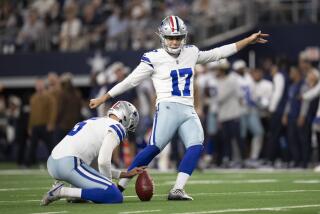An Unlikely Course of Help for Redskin Kicker Conway
It’s likely the Redskin season will come down to the right foot of 24-year-old Brett Conway. A rough deal, but there it is. A playoff spot may be decided by a young kid in the big slump.
What’s at stake? Coach Norv Turner’s job. The future of his assistants, including special teams coach LeCharls McDaniel. Dan Snyder’s leveraged $800 million investment. All riding on Conway’s loose cannon of a kicking leg. “A whole bunch of people’s lives and careers are on the fence,” says McDaniel.
Conway isn’t just in a slump. He’s in a nightmare. If you can miss field goals from 28 and 27 yards, you can miss from anywhere. What he needs is help. But where do you get it?
Perhaps, oddly enough, from golf. Any hacker who’s had the shanks or the snap hooks knows what Conway is enduring now. Small flaws in technique leads to self-inflicted mind games. And that leads to unbelievably humiliating failures.
How do you miss kicks that aren’t much longer than a high school extra point? Ask any golfer. How do you miss a one-foot putt? Or smother-hook a drive so it doesn’t reach the front tee? It’s the nature of the beast. And the beast has Conway.
Few motions in sport are more alike than the golf swing and the soccer-style field goal kick. The parallels are so strong that golf teacher Rick Smith, who works on Jack Nicklaus’ swing, did a TV program on the similarities with NFL kicker Eddie Murray.
“Even the common mistakes in the golf swing and field goal kicking are the same,” Smith said Wednesday.
In both, the pattern of the mistakes often identifies the problem. For example, in the last month, Conway has hooked three kicks left, one a smother hook. Once, he was far right. Twice, under pressure, he played for a draw only to “double cross” himself, by push-slicing the ball a couple of feet wide to the right.
“If you were describing a pro golfer who was hitting both hooks to the left and also blocking it dead right, there wouldn’t be much question what the problem was,” said Smith.
“Conway probably isn’t choking. He sounds like somebody with a technical problem,” said Smith. “He’s ‘overdrawing’ the ball--hooking it too much. He’s coming too much from the inside, then his foot snaps over” too much.
Golfers know this syndrome. One day, you hook one. Instinctively, to correct the mistake--to keep the ball from going left--you hit more toward the right. “It feels correct, but it’s exactly backwards,” says Smith.
The more you subconsciously aim right, the more your arms--or, in the case of a kicker, your leg--separate from your body. Instead of the whole body working together, with the torso controlling the motion and whipping the kicking leg through the ball, the leg suddenly has a mind of its own. It’s the boss, not the body.
“The ball can go anywhere,” said Smith. “You’re a loose cannon ready to go off-hook it left or block it right.”
Bad technique leads to bad shots. That leads to lost confidence, which leads to worry. And worry is just one step from fear--the ultimate enemy in both golf and kicking.
“For five years, Tom Watson was the best short putter that our statistics ever found,” says Dave Pelz, perhaps the most renowned short-game teacher in golf and another believer in the golf/kicking analogy. “Now, he can’t make one to save his life. The brighter you are, the more susceptible you are to worry, which leads to fear. Then it snowballs.”
Pro Beth Daniels was once so scared of one-foot putts that she would flinch in mid-stroke and repeatedly miss gimmes. It took Pelz six months to rehab her. Conway has six days between games. “If you’re scared as you finish your backswing--in golf or kicking--you’re dead,” said Pelz. “When you have a flaw, you need to fix it fast, before it gets ingrained.”
Pelz suggests Conway watch films of his best kicks over and over, as golfers do. “Your subconscious incorporates what it sees.” Unfortunately, “if you fix the wrong thing, you just get worse and you may never get better,” admits Pelz. “Late in their careers, that’s what happened to Arnold Palmer and Ben Hogan.”
Conway is a fascinating, extreme case. After success at Penn State, he fell apart in a head-to-head kicking competition for a job with the Packers. He arrived here with a “fragile psyche” reputation, which he had dispelled until recently.
And consider the Win Now pressure of the Dan Snyder regime. The owner’s kick-in-the-rear style may have motivated the team. Turner and veterans can take it. But what of Conway?
The right thing to do is stick with Conway and fix him. “Remember, Brett won two games for us this year,” says McDaniel. “He’s a talent. If he hits a big one, he might not miss again the rest of the year.”
If Conway butchers another big one, he may not miss again all year, either. Because he might not get another chance.
More to Read
Go beyond the scoreboard
Get the latest on L.A.'s teams in the daily Sports Report newsletter.
You may occasionally receive promotional content from the Los Angeles Times.










